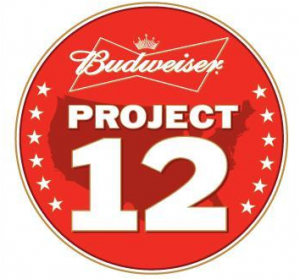
Normally I do not use this space to talk about Budweiser unless it is to kick them in the butt to make better beer since they have great brewers and great equipment and wads of cash to spend. But I have to today, because they have taken up one of my suggestions that I have ranted about on this blog. (OK, not because of me, I don’t think). They have actually given their brewers some leeway to make something other than the corn flavored fizzy water. I can’t vouch if it will be good. Their American Ale was a dreadful watered down amber but maybe, keep hoping, they will make something at least drinkable.
“Project 12.” Twelve Anheuser-Busch brewmasters at Budweiser’s 12 geographically dispersed breweries worked together to create their own “tribute” beers to fit the Budweiser brand’s reputation for quality and consistency. The assignment pays homage to Budweiser’s “clean and crisp” taste by using the proprietary yeast directly descended from the original Budweiser yeast culture used by Adolphus Busch in 1876 and still used by Budweiser today.
Through internal tasting and analysis, the 12 small-batch beers – each a lager using all-natural ingredients – were pared to six to take part in a summer-long, nationwide sampling effort. Consumer feedback will help Budweiser narrow the six beers to three for inclusion in a limited-edition sampler pack, available for purchase this fall.
To launch the six sampler beers, private events with brewmasters are scheduled to take place in August in all 12 A-B brewery cities: St. Louis, Mo.; Merrimack, N.H.; Baldwinsville, N.Y.; Newark, N.J.; Williamsburg, Va.; Cartersville, Ga.; Jacksonville, Fla.; Columbus, Ohio; Houston, Texas; Fort Collins, Colo.; Fairfield, Calif.; and Los Angeles, Calif.
Each small batch Budweiser is distinguished by the ZIP code where the beer is brewed. Among the six beers being sampled this summer and the brewmasters behind them:
Budweiser Small Batch 91406 (Los Angeles): A deep-amber lager with 6 percent ABV that uses four different types of hops. The beer is brewed by brewmaster Bryan Sullivan in Los Angeles and was developed in collaboration with Scott Ungermannin Fairfield and Dave Cohen in Houston.
Budweiser Small Batch 63118 (St. Louis): A deep-gold 5 percent ABV American lager that uses the same types of hops (Hallertau and Tettnang) commonly used at the St. Louis brewery during the 19th century. The beer is brewed in St. Louis by brewmaster Jim Bicklein and was developed in collaboration with Katie Rippelfrom Fort Collins.
Budweiser Small Batch 43229 (Ohio): A light-amber lager using eight different types of hops with 6 percent ABV. The beer is brewed in Columbus, Ohio, and was the brainchild of the brewery’s general manager, Kevin Lee and developed with assistant brewmasters Travis Burge and Tyler Hunter.
Budweiser Small Batch 23185 (Virginia): A light-amber all-malt bourbon cask lager aged on bourbon staves and vanilla beans and with an ABV of 5.5 percent. The beer is brewed by Daniel Westmoreland in Williamsburg and was developed in collaboration with Mike Anderson in Jacksonville and Dan Kahn in Cartersville.
Budweiser Small Batch 13027 (New York): A bright-golden lager brewed with six imported and domestic hops and with an ABV of 7 percent. The beer is brewed in Baldwinsville, N.Y., by brewmaster Nick Mills in consult with general managerSteve McCormick.
Budweiser Small Batch 80524 (Colorado): A deep-gold, filtered wheat beer with 5.2 percent ABV using lemon peel, orange peel and coriander. The beer is brewed by Katie Rippel in Fort Collins and was developed by Nick Mills in Baldwinsville,Otto Kuhn in Merrimack and Tiago Darocha in Newark.
“The key to this project was the common yeast – which is a very important and often under-appreciated contributor to the flavor and aroma of beer,” said Jane Killebrew-Galeski, director of brewing, quality and innovation for Anheuser-Busch. “We are proud of all these beers – the variety and the quality – but we want consumer feedback. So, we’re looking forward to what we hear when we sample this summer. Our objective is to allow our brewmasters to show some creativity, but the beers must fit the hallmarks the Budweiser brand is respected for, such as quality and consistency, and have a very crisp and clean taste.”
Though the range is still limited and the term “light” is used so as not to scare or offend those who have yet to discover craft beer at least there is a modest effort involved. I don’t think it will come close to matching the quality of the Sam Adams Longshot beers but this writer is very cautiously optimistic.